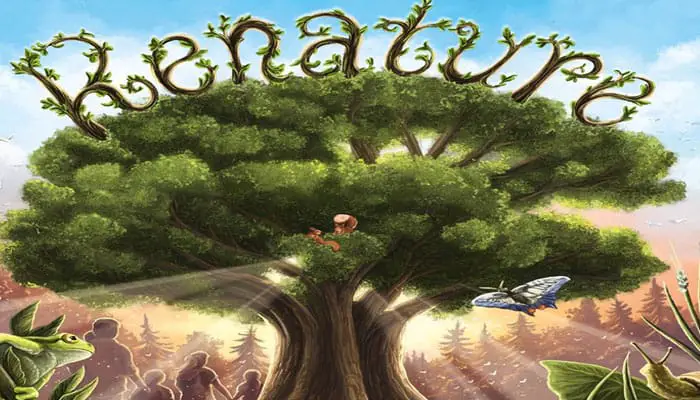
Components

- 1 game board
- 4 player boards
- 55 Dominoes
- 74 Plants
- 21 area tokens
- 4 score markers
- 30 Cloud Tokens
- 1 Joker Marker
- Instructions
Object of the Game
In a polluted valley, you have set yourselves the task of helping nature reclaim what is hers.
Along the course of a brook, you place dominoes with animals on them and replant the adjacent areas to score points.
When all dominoes have been played, the game ends with a final scoring and the player with the most points wins.
Setup
-
Place the game board in the middle of the table.


-
In a 3- or 4-player game: Each of you chooses a color and takes the player board with a balloon of that color. Place it with the balloon-side up in front of you.
In a 2-player game: One player takes both player boards with a white paraglider and the other player takes both player boards with a black paraglider.
Place your two boards side by side in front of you to form your player board:

-
Each player: Cover each plant space on your player board with a plant of that type and color. (You have spaces of your own color and the neutral color).
In 4-player games, leave spaces showing the
 - icon empty.
- icon empty.Return any spare plants to the box.

-
Place the green joker marker onto the butterfly space on the left side of the joker track.

-
There are 18 areas on the game board, each with a size number showing how many spaces are in it.
Shuffle the 21 area tokens face up and place one into each area. Make sure that the main points shown on each token matches the size number of its area.
Return the 3 spare area tokens to the box (without looking at their backs).
-
There are 4 area spaces on the game board marked with clouds. Place the shown number of cloud tokens onto each.
-
Each player: Place a cloud token onto each of the 6 cloud spaces on your player board. Return any spares to the box.

-
Shuffle the 55 dominoes face down and deal them out as follows:
- in a 4-player game, deal 13 to each player
- in a 3-player game, deal 18 to each player
- in a 2-player game, deal 26 to each player
Return any spares to the box (without looking at their fronts).
Each player: Without looking at them, place your dominoes face down beside your player board as your reserve. Then draw 3 and stand them horizontally in front of you, so that only you can see their fronts. These 3 dominoes form your hand.

-
The player who last went for a walk in nature becomes the starting player and places the score marker of their color onto space 4 of the score track. Going clockwise, the next player places their marker onto space 3, the third player (if any) onto space 2 and the fourth player (if any) onto space 1.

Game Play
The starting player begins the game by taking a turn. Then play proceeds clockwise with players taking one turn each until nobody has any dominoes left and the game ends.
On your turn, carry out the following steps in this order:
-

Place 1 domino from your hand onto the game board or return 1 to the box.
-

If you placed a domino, you may place 1 plant onto a free area space beside it.
-

1) If you placed a plant, score points for it. 2) Check if you triggered any area scorings.
-

If possible, refill your hand with 1 domino from your reserve.
In addition, throughout your turn, you may spend cloud tokens to perform cloud actions.
Then it's the player to your left's turn.
A.  Place 1 domino onto the game board
Place 1 domino onto the game board
Choose a domino from your hand and place it face up onto the game board:
-
Each of its two halves must cover a free brook space.

-
It may not protrude into any area
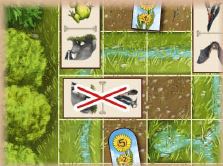
-
or beyond the grid.

At least one of its halves must be beside a matching animal or on one of the four starting spaces.

The joker marker shows the current joker animal. This animal can be placed beside any animal and any animal can be placed beside it. (At the start of the game, the butterfly is the joker animal. The joker animal can be changed by a cloud action ).

All animals beside each other must match. If there is even one mismatch, you can not place your domino that way.

B.  Place 1 plant onto the game board
Place 1 plant onto the game board
After placing a domino onto the game board, you may place a plant beside it:
Take any plant from your player board. Its type and color may affect how many points you score in step C (see next section).

Place it onto a free area space beside the domino you just placed. An area space is free if there is no plant on it.
If an area token is in the way when you place your plant, move the token to any free part of that area. (It will only be removed after its area is scored - see step C).
If you place your plant onto an area space that has any cloud tokens on it, place them onto free cloud spaces on your player board. If you have no free cloud spaces for them, either make room by immediately performing a cloud action or return them unused to the box.

Note: The faint point number on each cloud token serves as a reminder that at the end of the game you gain 1 point for each cloud token on your player board.
If there are no free area spaces beside your domino, you can not place a plant.
Note: At the end of the game, you'll lose points for any plants left on your player board. So don't miss out on this step too often.
C.  Score points for your plant
Score points for your plant
1. Points for your Plant
If you placed a plant in step B (of your color or neutral), score points for it now:
Gain 1 point for the plant itself and 1 point for each plant (of any color) in that area with equal or lower value. The value of each plant is shown by its height:

Mark your points on the score track by moving your score marker forward accordingly. (There can be several score markers on the same space).

Example:
-

In an empty 4-space area, Mary places a bush and scores 1 point.
-
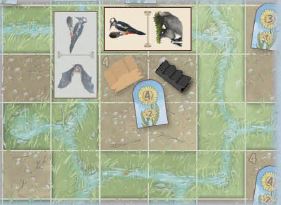
Frank, on his turn, places a turf in the same area and scores 1 point (he doesn't score for the orange bush since it is of a higher value than his turf).
-
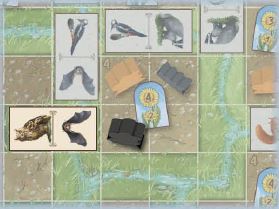
On a later turn, Frank places a bush in the same area and scores 3 points (1 for that bush, 1 for the orange bush and 1 for his turf).
-
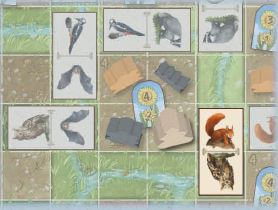
On her next turn, Mary places a neutral pine in that area and scores 4 points.
2. Check if any area scorings are triggered
At the end of step C, check if your domino has closed off any areas. An area is closed off if each of the brook spaces beside it is either:
- covered by an animal or
- isolated.
A brook space is isolated if there is no free brook space beside it (which means it can never receive a domino).
Remember: Brook spaces that are diagonally adjacent to an area - are not beside that area. So the area can be closed off even if any of them are free.
For each area that you closed off this turn, a separate area scoring is triggered now:
To score an area, first calculate each color's total value by summing the values of its plants within the area.
Any colors whose total values are tied are treated as though they are not present.

If nobody's color is present, no points are scored. Otherwise continue as follows:
If only one color is present and it belongs to a player (i.e. isn't neutral), that player scores both the main and minor points shown on this area's area token.
Otherwise, if the highest value is a player's color, that player scores the main points shown. If it's neutral, these points are not scored.
If the second-highest value is a player's color, that player scores the minor points shown. Again, if it's neutral, these points are not scored.
There are no points for third-, fourth- or fifth-highest values.

Finally, take the area token and place it face up in front of you (because you were the one who closed off its area).
Note: Each area token has a number of points faintly printed on its back. These points will be awarded at the end of the game. You are allowed to look at the backs of your own area tokens (gained by closing off areas) but should keep them secret until the final scoring.
D.  Refill your Hand
Refill your Hand
Refill your hand with a domino drawn from your reserve. Then your turn ends.
If your reserve is empty, skip this step and do not refill your hand for the rest of the game.
Once you are out of dominoes, your turn is skipped for the rest of the game. Players who still have dominoes continue taking their turns as usual.
Cloud Actions
On your turn, in addition to steps A to D, you may perform any number of cloud actions.
Each cloud action costs cloud tokens, which you must return from your player board to the box. There are 3 types of cloud action:
Change the Joker Animal

At any time in your turn, you may spend 2 cloud tokens to change the current joker animal by moving the joker marker to any space on the joker track.
Take Another Turn

At the end of your turn, you may spend 3 cloud tokens to immediately take another turn. You may take as many turns in a row as you can afford.
Return plants from the game board to your player board
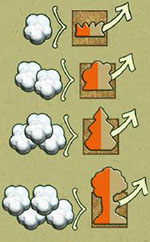
At any time in your turn, you may spend cloud tokens to return a plant from the game board (even from a closed-off area) to your player board:
For each plant that you return, you must spend a number of cloud tokens equal to its value.
You can only return plants of your own color or the neutral color. This can be any neutral plant (irrespective of who placed it) but you must have a free space of the right color and shape for it. (In a 4-player game, plant spaces with the  -icon are not free).
-icon are not free).

End of the Game
When everyone has run out of dominoes, the game ends. Then carry out the final scoring as follows:
First, score any areas that still have area tokens. Go through them one by one. For each, carry out the area scoring as described in the yellow-framed section on page 6, but return its area token to the box afterwards.
Once those areas have been scored, each player also scores as follows:
- For each cloud token on your player board, gain 1 point. -
- Lose points equal to the value of each plant on your player board.
- Finally, flip any area tokens you collected and gain the points printed on their backs. -
Once the final scoring is complete, the player with the most points wins. Ties are broken in favor of the player with more area tokens. If still tied, the victory is shared.
Continue Reading
